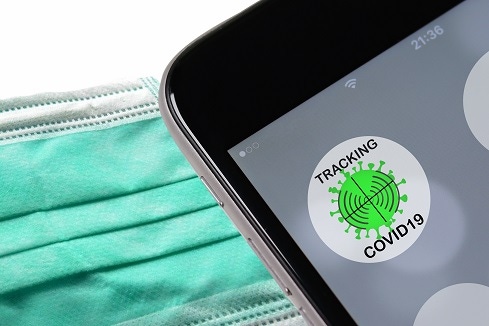There are weaknesses and obstacles in the way, but in lieu of a vaccine and widespread testing for COVID-19, contact-tracing apps might be at least a useful interim tactic.

Pandemics stir up mass panics that are hard to control. They inject massive amounts of fear, uncertainty, and doubt into the general population.
The current COVID-19 emergency has produced an infodemic of overwhelming proportions. Though there’s plenty of authoritative advice for coping with the novel coronavirus, scared human beings are grabbing desperately for any advice, no matter how suspect.
Protecting ourselves in a pandemic may come down to following simple rules of thumb. We should stay home, wash and sanitize our hands constantly, wear surgical masks in public, keep a six-foot distance from others, avoid touching our faces, and seek prompt medical attention if we believe we’ve been infected.
Groping for actionable counter-contagion analytics
Data-driven analytics can help us protect ourselves in a pandemic. However, it’s not clear what kinds of analytic-driven apps might best help individuals to ward off invisible pathogens.
Contact-tracing apps have grabbed a lot of headlines recently, and many people seem to regard them as possible tool for flattening COVID-19’s infection curve. These apps have been in the IT industry news recently, thanks to Apple and Google’s announcement that they are partnering to build mobile-based apps that will work on both IOS and Android devices. Also, the European Commission earlier this month announced a strategy for COVID-19 mobile contact tracing and alerting.
Essentially, these apps, which may be implemented in smartphones or Internet of Things devices, alert people to the risk that they have been exposed to a person who is either ill, infected, or asymptomatically carrying the virus. Using sophisticated data analytics, the apps alert users when they come close to another user who has tested positive. Optionally, the apps may guide impacted users on the best next steps, such as testing, quarantining, and social distancing.
Too little, too late?
Contact-tracing apps can only be effective in countering a pandemic’s spread if they provide useful advice to many people before the contagion would have petered out on its own. However, the Apple-Google initiative released its first deliverable -- an API for integration with third-party contact-tracing apps -- just as the hoped-for curve flattening had already begun in many regions of world.
What that means is that API-integrated contact-tracing apps will hit the market weeks or months after the demand for them has started to wither away. In addition, the promised follow-on deliverable --embedding of common contact-tracing technology in both IOS and Android devices -- will be much too late to make a serious dent in a pandemic that (we all hope and pray) will be history by then.
Even if Apple-Google had started their initiative back in December when the pandemic started in Wuhan, China, and had delivered their planned API and app promptly at that time, their efforts probably would not have made a difference in slowing the contagion’s spread. Any of the other efforts around the world to address the pandemic with a contact-tracing app would have faced the same challenge of getting a solution into people’s hands fast enough.
Rapid enough adoption of the Silicon Valley dynamic duo’s handiwork would have depended on the lightning convergence of several trends.
For starters, most of a population needs to use a common contact-tracing application for it to have reasonable chance of stalling a pandemic. An estimate in a recent Oxford University study put the threshold adoption rate at 60%.
For that to happen, most people would need to use phones that are compatible with the dominant contact-tracing app. That’s a tall order, considering that people tend to take years to change out their mobiles, and they’re definitely not going to do it just to use one application of uncertain value.
Furthermore, the dominant contact-tracing app in a country or region would have to be certified and/or sponsored by a government health authority. This is practically the only way that a large enough proportion of people in each country would download, install, and use such an app. One problem with this is that it might take precious weeks or months for different countries’ apps to integrate with a common Apple-Google offering, by which time the crisis may be long over.
Also, any top-down effort to get people to download and use a contact-tracing app in a crisis would run up against popular distrust of government agencies. There would need to be an accelerated public service campaign to address people’s concerns and encourage them to participate. And it would be especially difficult to make this case in countries such as China, Singapore, France, Australia, and Israel, where the apps inform health authorities that you may be infected and they in turn notify you on the proper next steps.
In addition, the well-known privacy and civil rights implications of contact-tracing apps may deter many users from adopting them in the first place. Let’s note that even in a paternalistic surveillance state such as Singapore, only about 12% of the population downloaded the government-issued TraceTogether contact-tracing app.
Reliance on Bluetooth
Another potential obstacle to the success of contact-tracing apps is that many rely on Bluetooth, though some use the less precise GPS or Wi-Fi signals for proximity sensing. There are several downsides to Bluetooth that will dilute any contact-tracing app’s ability to deliver high-quality data on COVID-19 exposure and infection:
Bluetooth is a wireless interface that users will have to remember to turn on when they leave their homes, a fact that will result in many devices being undetectable in the field.
Bluetooth is notoriously unreliable when pairing devices, so it may not automatically detect a substantial percentage of other users’ devices that have this wireless interface turned on in one’s immediate vicinity.
Bluetooth’s range is considerably wider than 6 feet -- anywhere from 30-330 feet -- which will almost assure a high percentage of false positives regarding people’s exposure to the virus.
Bluetooth is insecure, with its signals vulnerable to being harvested and imitated by hackers, such as a Bluetooth-equipped phone being driven through urban areas that impersonates a COVID-19 case and thereby tricks many people’s contract-tracing apps into misclassifying themselves as exposed to the virus.
Bluetooth will detect devices that are separated by walls, floors, ceilings, windows, and other obstructions, as well as devices that are simply powered on without their users anywhere nearby.
Bluetooth may drain device batteries to the point that many may power off before they can gather enough data for determining a user’s exposure to virus carriers.
Human factors
There are only so many critical alerts that the average user can tolerate before they tune it all out in order to get on with their life. The likelihood that contact-tracing apps will bombard users with false positives may cause many people to abandon them.
Another weakness of contact-tracing apps is that they rely on users to manually opt-in and self-report if they believe they’ve been exposed. Obviously, someone who has just been notified that they may have fatal disease may have other, more important things on their mind than the need to altruistically report this to the world at large. In such circumstances, they may rush to a hospital and entirely forget to self-report.
Or a user may wait until after being tested before self-reporting, and only do so if they’ve tested positive. But that delay may reduce their likelihood of self-reporting even further. And if they live in an area where it’s difficult or impossible to find a competent healthcare professional to test them, they may never get around to self-reporting.
That same user may eventually download the app, in anticipation of the dreaded second wave of infections months later. By that time, however, society may have started to take this outbreak in stride and healthcare institutions may have access to ample testing, vaccination, and treatment programs that obviate the need for people to vigilantly self-report their exposure.
Takeaway
Globally, the many contact-tracing applications under development are laudable. In lieu of a vaccine and widespread testing for COVID-19, contact-tracing apps can be a useful interim tactic.
Contact-tracing apps can function as supplements to the contract-tracing exercises that healthcare professionals routinely perform when a contagion has begun to spread within a population. They can also serve as a personal early warning system and recommendation engine for individuals.
However, it’s unlikely that the apps -- even if delivered to market the moment a pandemic takes root --can make a serious dent in preventing its spread.
About the Author(s)
You May Also Like







